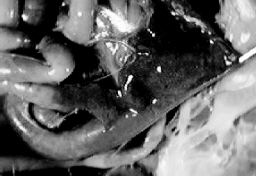ThePoultrySite Quick Disease Guide
Haemorrhagic Enteritis
|
Extracted From:
A Pocket Guide to
Poultry Health and Disease 
|
Introduction
A viral disease of turkeys, similar to pheasant Marble Spleen disease, caused by Type II Adenovirus distinct from classical fowl adenovirus and occurring in most turkey-producing areas. The virulence of the virus varies but morbidity may be 100% and mortality 10-60%.
The source of virus is unknown but there is easy lateral spread within flocks, the virus surviving in frozen faeces for months, and weeks in litter. The route of infection is usually oral.
Signs
- Sudden deaths.
- Blood from vent of moribund birds.
- Drop in feed and water consumption.
- Diarrhoea.
- Course 10-21 days.
- May induce immunosupression and precipitate respiratory disease or coccidiosis.
Post-mortem lesions
- Petechiae in various tissues.
- Intestine distended with blood.
- Spleen mottled and enlarged.
- Microscopic - spleen shows lymphoid hyperplasia, reticulo-endothelial hyperplasia and intranuclear inclusions.
Diagnosis
Typical lesions, reproduction with filtered contents, double-immuno-diffusion of splenic extract. Serology: DID, Elisa - sero-conversion frequently occurs in absence of clinical disease.
Treatment
Warmth and good management, convalescent serum, oral tetraycline. Disinfect and 3-4 weeks house rest.
Prevention
All-in/all-out production, good hygiene and biosecurity, good management. Live vaccines are commonly used in many countries at 4-5 weeks of age. Some are produced in live turkeys, some in turkey B-lymphoblastoid cell lines. Maternal antibody may interfere with vaccination.
Immunity: there is an early age resistance irrespective of maternal antibody status. Pathogenic strains can depress both B- and T-line lymphocytes for up to 5 weeks following exposure. Immunity to the disease is long lasting.
 |
| Figure 39. Turkeys dying with haemorrhagic enteritis commonly have the small intestine distended with blood. In this case a loop of intestine has been opened to show the blood. |


 © 2000 - 2021. Global Ag MediaNinguna parte de este sitio puede ser reproducida sin previa autorización.
© 2000 - 2021. Global Ag MediaNinguna parte de este sitio puede ser reproducida sin previa autorización.